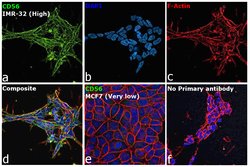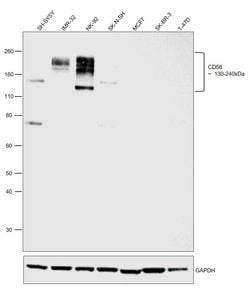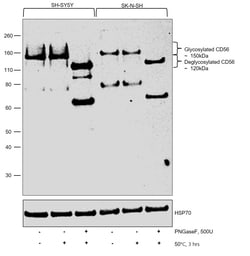Learn More
Invitrogen™ CD56 Monoclonal Antibody (123C3)
Mouse Monoclonal Antibody
$510.00 - $670.50
Specifications
| Antigen | CD56 |
|---|---|
| Clone | 123C3 |
| Concentration | 1 mg/mL |
| Content And Storage | Store at 4°C short term. For long term storage, store at -20°C, avoiding freeze/thaw cycles. |
| Applications | ELISA, Flow Cytometry, Immunohistochemistry (Frozen), Immunohistochemistry (Paraffin), Western Blot, Immunocytochemistry |
| Catalog Number | Mfr. No. | Quantity | Price | Quantity & Availability | |||||
|---|---|---|---|---|---|---|---|---|---|
| Catalog Number | Mfr. No. | Quantity | Price | Quantity & Availability | |||||
|
PIMA516445
|
Invitrogen™
MA516445 |
200 μg |
Each for $670.50
|
|
|||||
|
PIMA516446
|
Invitrogen™
MA516446 |
100 μg |
Each for $510.00
|
|
|||||
Description
Heat-mediated antigen retrieval using a sodium citrate buffer (pH 6.0) is recommended for the staining of paraffin sections. For FACS analysis, use 10 μL of the suggested working dilution to label 1x10^6 cells in 100 μL. Mouse anti Human CD56 antibody, clone 123C3 recognizes human neural cell adhesion molecule (NCAM), otherwise known as CD56.
CD56 (NCAM, neural cell adhesion molecule) is a transmembrane glycoprotein of the immunoglobulin family that serves as an adhesive molecule and is ubiquitously expressed in the nervous system in isoforms ranging from 120-180 kDa. CD56 is found on T cells and NK cells, and is involved in cell migration, axonal growth, pathfinding and synaptic plasticity. Polysialic modification results in reduction of CD56-mediated cell adhesion. Through its extracellular region, CD56 mediates homophilic and heterophilic interactions by binding extracellular matrix components such as laminin and integrins. CD56 is expressed on most neuroectodermal derived cell lines, tissues and neoplasms such as retinoblastoma, medulloblastoma, astrocytomas and neuroblastoma. Further, CD56 is a widely used neuroendocrine marker with a high sensitivity for neuroendocrine tumors and ovarian granulosa cell tumors. Diseases associated with CD56 dysfunction include rabies and blastic plasmacytoid dendritic cell neoplasms.Specifications
| CD56 | |
| 1 mg/mL | |
| ELISA, Flow Cytometry, Immunohistochemistry (Frozen), Immunohistochemistry (Paraffin), Western Blot, Immunocytochemistry | |
| Unconjugated | |
| Mouse | |
| RUO | |
| PBS with 0.09% sodium azide | |
| P13591 | |
| 4684 | |
| Small cell lung carcinoma. | |
| Antibody |
| 123C3 | |
| Store at 4°C short term. For long term storage, store at -20°C, avoiding freeze/thaw cycles. | |
| Monoclonal | |
| Liquid | |
| IgG1 | |
| Human | |
| Ncam1 | |
| adhesion molecule; antigen recognized by monoclonal antibody 5.1H11; Cd56; CD-56; CD56 120 kDa GPI-linked isoform; CD56 140 kDa isoform; CD56 140 kDa VASE isoform; E NCAM; E-NCAM; MSK39; N CAM1; NCAM; N-CAM; Ncam1; N-CAM-1; NCAM-1; NCAMC; NCAM-C; neural cell adhesion molecule; Neural cell adhesion molecule 1; neural cell adhesion molecule, NCAM; sCD56; sNCAM; soluble CD56; soluble NCAM | |
| Ncam1 | |
| Primary | |
| Protein A |
Your input is important to us. Please complete this form to provide feedback related to the content on this product.


